The Process of EMDR Therapy: a Comprehensive Guide to Its Advantages and strategies
EMDR treatment attracts attention as a structured method for addressing distressing memories. Its multi-phase approach and incorporation of reciprocal stimulation techniques set it apart from conventional treatments. By assisting in the reprocessing of traumatic experiences, EMDR supplies a distinct pathway to recovery. What particular strategies are utilized, and what advantages do they give injury recuperation? Discovering these aspects exposes a much deeper understanding of this reliable healing alternative.
Comprehending EMDR Treatment: An Introduction
EMDR treatment, or Eye Motion Desensitization and Reprocessing, is a psychotherapy technique created to alleviate the distress connected with traumatic memories. Established by Francine Shapiro in the late 1980s, EMDR incorporates aspects from various healing methods, including cognitive-behavioral therapy and psychodynamic therapy. The key objective of EMDR is to assist people procedure and reframe stressful memories, minimizing their psychological charge and linked symptoms.
During EMDR sessions, customers participate in double attention stimuli, typically entailing guided eye activities, while remembering distressing memories - emdr therapy new york. This procedure allows the mind to recycle the memory in a much healthier manner. EMDR has gained recognition for its efficiency in dealing with Anxiousness, anxiety, and ptsd, to name a few problems. Research has actually revealed that EMDR can cause significant renovations in psychological wellness. As an organized intervention, it uses a thorough framework for specialists to assist clients in getting over the impact of past injuries
The 8 Stages of EMDR
While numerous therapeutic strategies vary in framework and technique, the 8 phases of EMDR give a methodical framework that overviews the restorative procedure. These stages start with the history-taking and therapy planning, where the therapist gathers pertinent information regarding the client's experiences and establishes a secure atmosphere. The second stage focuses on preparation, gearing up clients with devices to manage psychological distress.
In the third phase, clients determine certain memories to target. The 4th stage entails desensitization, where clients refine these memories while taking part in bilateral stimulation. The 5th stage emphasizes installment, reinforcing positive ideas. The sixth phase addresses body check methods to determine any recurring tension.
The final 2 phases involve closure, returning customers to a state of balance, and reevaluation, examining the effectiveness of the therapy. This organized approach warranties that EMDR treatment is extensive, resolving both the mental and physiological elements of trauma.
Key Methods Made Use Of in EMDR Procedure
In EMDR sessions, therapists make use of details methods to help with recovery and handling of distressing memories. Secret among these are bilateral excitement techniques, which engage both hemispheres of the mind, and various memory handling techniques that help clients reframe their experiences. Comprehending these techniques is essential for realizing the performance of EMDR treatment.
Reciprocal Excitement Methods
Bilateral stimulation methods are essential techniques used throughout EMDR sessions to help with the processing of traumatic memories. These techniques include engaging both hemispheres of the brain, promoting assimilation and recovery. Typical bilateral excitement methods include auditory signs, such as alternating sounds or tones, and tactile excitement, via using handheld tools that develop alternating taps. Visual stimuli, such as the therapist assisting the customer's eye movements from side to side, are also widely used. The rhythmic nature of these techniques assists to turn on the mind's all-natural handling abilities, enabling clients to reprocess distressing memories in a secure environment. Eventually, bilateral stimulation fosters a feeling of safety and security and improves the restorative experience throughout EMDR.
Memory Processing Techniques
Memory handling strategies in EMDR sessions are essential for helping customers confront and remodel traumatic experiences. These strategies concentrate on facilitating the reprocessing of upsetting memories, permitting clients to incorporate and deal with negative emotions associated with them. One trick approach includes using bilateral stimulation, which can consist of responsive sensations or auditory tones, to enhance the mind's info handling capacities. During sessions, clients are guided to remember certain memories while at the same time taking part in bilateral stimulation, advertising a dual concentrate on the distressing memory and the present moment. This strategy aids in minimizing the psychological fee of the memory, making it much less invasive. Inevitably, memory processing strategies equip customers to rebuild their stories, promoting recovery and strength.
The Function of Reciprocal Excitement
Reciprocal excitement is a fundamental element of EMDR therapy, helping with the handling of traumatic memories. Different strategies, such as auditory, responsive, and aesthetic stimulation, are employed to engage both hemispheres of the brain. This approach has actually been shown to enhance trauma recovery by promoting psychological regulation and decreasing distress related to past experiences.
System of Reciprocal Stimulation
The system of bilateral excitement plays a crucial duty in helping with the processing of terrible memories when people involve in EMDR therapy. This method entails rotating excitement, typically via auditory, responsive, or aesthetic means, which activates both hemispheres of the brain. The rhythmic nature of reciprocal excitement is believed to mimic the mind's natural handling mechanisms during REM sleep, promoting integration of distressing memories. As clients concentrate on their traumatic experiences while simultaneously participating in this stimulation, they may experience a reduction in psychological fee related to those memories. This procedure enables for the reprocessing of trauma, leading to enhanced emotional law and a much more adaptive viewpoint on previous occasions.
Sorts Of Stimulation Strategies
Different excitement methods are utilized in EMDR treatment to improve the reprocessing of stressful memories. The primary approach is bilateral stimulation, that includes auditory, visual, and responsive methods. Acoustic stimulation often includes rotating sounds played via earphones, while aesthetic stimulation can consist of directed eye motions back and forth. Responsive stimulation may utilize handheld tools that produce rotating taps on the customer's hands. Each of these strategies intends to engage both hemispheres of the mind, facilitating a more reliable handling of upsetting memories. Practitioners might choose one or a combination of these techniques based on customer preferences and therapeutic objectives, guaranteeing a tailored method to healing. These methods are essential for promoting a deeper integration of stressful experiences within the therapeutic structure.
Benefits for Trauma Healing
The role of bilateral excitement in EMDR therapy considerably adds to trauma recuperation by helping with the handling of upsetting memories. This strategy involves alternating sensory input, normally through eye activities or auditory tones, which aids in incorporating traumatic experiences. By involving both hemispheres of the brain, bilateral excitement boosts emotional guideline and reduces the strength of stressful memories. Study suggests that clients typically experience a reduction in anxiousness and a raised capacity to face traumatic thoughts. In addition, this technique advertises cognitive flexibility, allowing people to reframe their experiences in a much more adaptive fashion. Eventually, the usage of reciprocal stimulation in EMDR treatment plays an important duty in allowing individuals to achieve lasting recovery and strength in the face look at more info of trauma.
The Science Behind EMDR: How It Functions
Although the precise devices of Eye Activity Desensitization and Reprocessing (EMDR) treatment are still being checked out, research study suggests that it facilitates the handling of distressing memories by incorporating sensory, psychological, and cognitive parts. EMDR uses reciprocal stimulation, usually with led eye activities, which is thought to simulate the mind's natural handling during rapid eye movement rest. This stimulation might assist clients access and reprocess distressing memories, decreasing their emotional cost.
Neuroscientific researches suggest that EMDR may modify the means distressing memories are stored in the brain, promoting adaptive resolution. The treatment urges people to challenge their memories and linked ideas, allowing them to reframe their experiences. Furthermore, the structured phases of EMDR-- such as desensitization, history-taking, and installation-- support an extensive expedition of the injury, promoting integration of the fragmented facets of the memory. This procedure eventually aims to bring back a sense of stability and emotional well-being.
Benefits of EMDR for Injury Recuperation
EMDR therapy supplies many benefits for people recouping from injury, specifically by attending to the psychological and cognitive distortions linked with distressing experiences. One significant benefit is its capability to assist in quick processing of distressing memories, often causing a decrease in signs and symptoms such as anxiety and clinical depression. This strategy allows clients to confront their injury in a organized and risk-free atmosphere, fostering resilience and emotional law.
Furthermore, EMDR helps people reframe negative beliefs connected to their injury, advertising a healthier self-image and bring back a feeling of control. The therapy can improve total psychological wellness and encourage customers to restore their lives, making it a beneficial tool in injury recuperation. EMDR is appropriate for numerous age groups and can be adjusted to satisfy the specific requirements of individuals, making it a versatile alternative for those looking for to recover from their stressful experiences successfully.
That Can Take Advantage Of EMDR Therapy?
Individuals from diverse backgrounds and experiences can profit from EMDR treatment, especially those that have run into trauma in different forms. This includes survivors of youth abuse, natural catastrophes, accidents, and battle experiences. Furthermore, people dealing with trauma (PTSD) often locate EMDR to be an efficient therapy choice.
Beyond injury, those managing stress and anxiety, clinical depression, fears, and other mental wellness problems might likewise experience renovations with EMDR. The treatment can help in fixing upsetting memories that add to these problems.
EMDR is not limited to adults; teens and children can likewise profit, especially when adapted to their developmental demands. In general, EMDR treatment supplies a functional approach, making it appropriate for a wide variety of people looking for recovery from emotional discomfort and mental distress. Its structured yet versatile nature enables specialists to customize the therapy to fulfill particular customer requirements.
Regularly Asked Concerns
For how long Does an EMDR Therapy Session Typically Last?

Is EMDR Treatment Ideal for Children?
EMDR therapy can be appropriate for children, as it has actually been adjusted to address their unique developmental needs. Correctly educated therapists can efficiently carry out techniques that aid children process stressful experiences in a supportive setting.
What Should I Expect After an EMDR Session?
After an EMDR session, people might experience emotional release, short-term fatigue, or increased feelings. Some report enhanced quality and alleviation, while others may really feel a requirement for extra handling time to integrate their experiences effectively.
Exist Any Kind Of Adverse Effects of EMDR Therapy?

Just how Do I Locate a Certified EMDR Specialist?
To locate a certified EMDR therapist, people need to seek recommendations from healthcare providers, confirm credentials with expert companies, and speak with on-line directories. Making certain appropriate training and experience in EMDR is crucial for effective treatment.
Reciprocal excitement is an essential element of EMDR therapy, promoting the processing of traumatic memories. When people engage in EMDR treatment, the mechanism of bilateral stimulation plays a vital function in assisting in the handling of distressing memories. Various stimulation methods are utilized in EMDR treatment to improve the reprocessing of distressing memories. The function of bilateral excitement in EMDR therapy considerably adds to trauma recuperation by promoting the processing of distressing memories. The precise devices of Eye Motion Desensitization and Reprocessing (EMDR) therapy are still being discovered, research study suggests that it promotes the handling of distressing memories by integrating sensory, psychological, and cognitive parts.